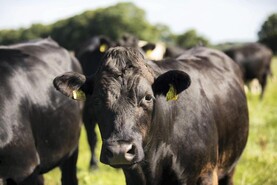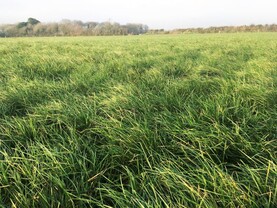The international bull fertility conference gave an in-depth insight into fertility problems in bulls worldwide, from pre-breeding examinations to identification of abnormal sperm.
The final day of the event proved one of the most educational to attendees, with a live demonstration of a breeding soundness and semen evaluation examination. Above all else, it showed why it’s essential for breeders undertaking fertility tests to acquire a veterinary physician.
On-farm semen testing has become the norm for the majority of pedigree breeders over the last number of years. However, if not undertaken by a vet, not only has the breeder no cover if it was to go further but also the test could predict a false positive result.
Fertility tests alone are no good. Bulls need a pre-breeding examination.
The aim of a pre-breeding examination is to try to identify bulls that are potentially unfit for use. Bulls fail these examinations for a number of reasons, not just on semen quality.
This is where vets come into their own. Everything from body condition, docility, feet and legs to testicles, sheath and general clinical signs are examined before taking a semen sample.
Once the semen sample is collected it will generally be examined for motility and progression. This is simply not enough as samples need to be tested for sperm morphology to identify any sperm defects also.
Sperm defects do not impair motility but have a significant effect on fertilising capacity, so even when a sample is excellent for motility it needs to be examined.
While the positive shift in breeders getting examinations undertaken on their breeding bulls pre-sale can only be good, it’s worth knowing what’s actually being examined. Breeders as well as buyers want to be assured that the examination of their bulls is the one which will give the most accurate result.
Bull production in Ireland
This topic worked well in line with Doreen Corridan’s very informative overview of pedigree bull production in Ireland. Stock bulls sire 30-50% of calves born in the Irish dairy herd, while almost 80% of the beef herd is bred to stock bulls.
To meet this demand, Ireland produces nearly 38,000 pedigree beef calves per year. Most breeders are of the opinion that because they carry papers they should be used as breeding stock. This, however, should not be the case. Breeders need to only select the top bulls to go on and breed with the rest run as commercial stock and killed.
Doreen highlighted to the audience the current BDGP and looked at how bulls which were sold for breeding performed in their new herd. Outlining why this population provided the most valid data due to all progeny being recorded, she said all bulls are genotyped and the new owners have to provide reasoning for culling or selling.
There were around 16,000 pedigree beef bulls born in 2013, of which 8,600 were sold to herds for breeding and of these you can see 2,758 were sold into BDGP herds.
In Table 1, the details of how many bulls had been culled since being purchased by the BDGP herds are shown. Here, we see 23% of bulls purchased as stock bulls by BDGP participants have already been killed. This varies among breeds, ranging from as low as 13% up to 100%. However, the key information comes in Table 2 when we see the reasons for culling these bulls.
We see that the reason over 45% of bulls were culled was to do with either injury or feet/legs and lameness. Fertility stands at only 7.2%, which may have been higher in the past, but there has been a surge in the number of bulls being fertility-tested in the past five years.
Doreen states: “The majority of injuries can be avoided by not allowing bulls run with females until they are confident in mating, having appropriate ratios of females to the bull and taking cognizance of bull’s age and not over working young bulls.”
She also highlighted the production system of young bulls in Ireland – selling bulls at 12 to 18 months, at relatively small money with breeders looking to the show ring success to increase the bull’s value. In doing this, breeders are pushing their animals at a young age to gain high weights, express extreme muscling and high fat scores. In turn, customers now look for these attributes when selecting their next stock bull.
While it’s easy to see why it’s wanted, showing the genetic potential of the bull, it leaves buyers with a bull fit for slaughter rather than service. This excessive feeding has severe consequences with regard to health and indeed feet/legs and lameness. Having 22% of beef bulls which work in beef herds, which in the majority of cases have limited walking to do compared to that of their comrades in the dairy herd is too much. It’s from points like this we need to learn.
Doreen said: “The level of feeding required from an early age to compete at the pre-sale shows at 12-15 months has a negative impact on the musculo-skeletal system, hoof quality, liver and testicular function. To maximise fertility, and reduce issues with feet and legs, bulls need to grow naturally having not being overfed from a young age.”
By overfeeding at a young age, there is an increased chance of reduced fertility for a number of reasons. Last week, Darren Carty touched on how overfeeding and excessive feeding of bulls can lead to an inability to thermoregulate their testes. This is largely down to a higher level of scrotal fat impairing an animal’s ability to regulate temperature.
It may take up to six weeks for sperm to return to normal following damage caused by excessive testicular temperature.
The topic of testicular degeneration also arose at the conference when talking about the overfeeding of young cattle. Depending on the severity and the cause of testicular degeneration it may take up to four months to regenerate sperm.
Fertility
Finalising, Doreen highlighted the fact that the majority of bulls bought in Ireland are purchased at the time they are needed to work. The severe change in feeding and exercise leads to a rapid drop in weight and bulls fatigue quickly, both of which have an effect on fertility.
She stated that a “cultural change is needed by both the breeder and buyer to get them thinking in line”.
Pedigree breeders will continue to breed for the market, but they need to encourage this culture change in their customers. Advise buyers to look at purchasing a bull earlier, using them at an older age, using them on a smaller number first season and undertaking the proper transition from sale day to service day.
This is the only way that in time the lifespan of the pedigree bull on farm will increase, in turn increasing the initial purchase price.






 This is a subscriber-only article
This is a subscriber-only article













SHARING OPTIONS: